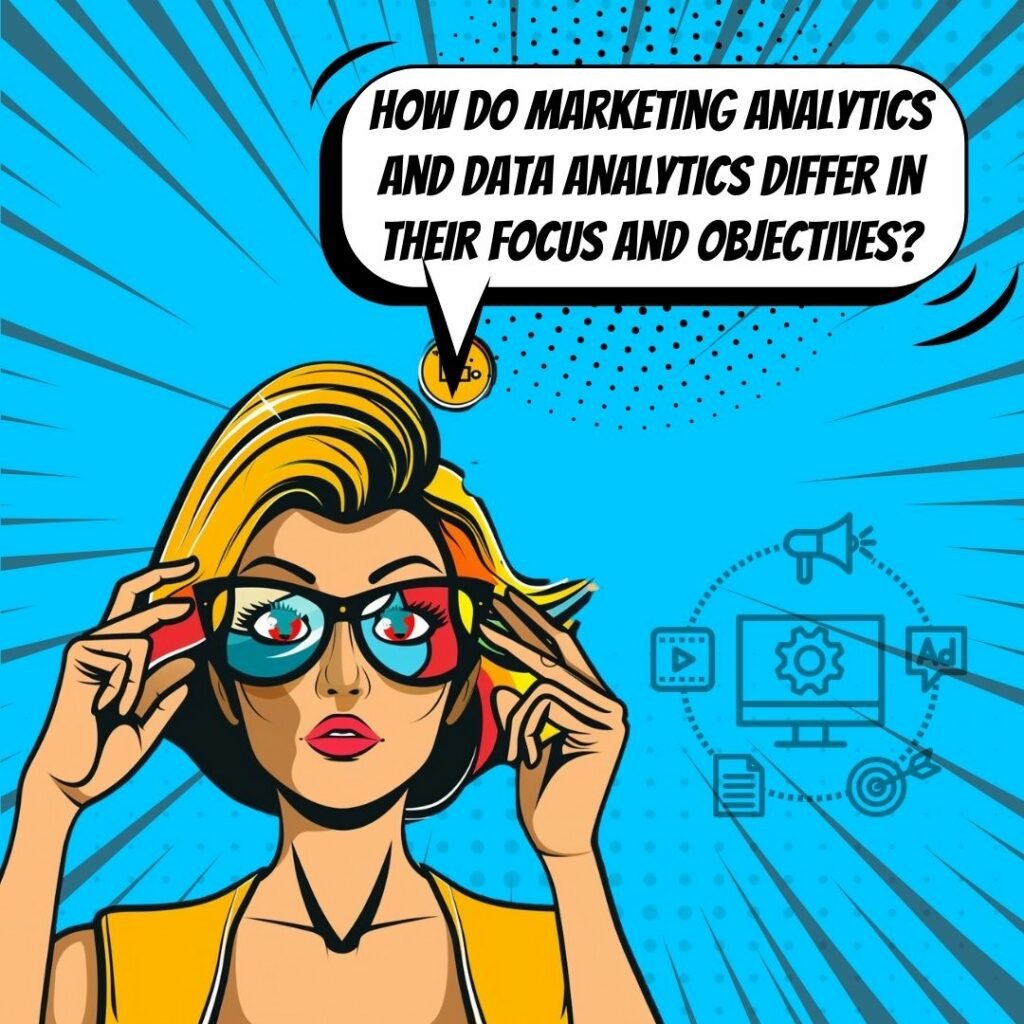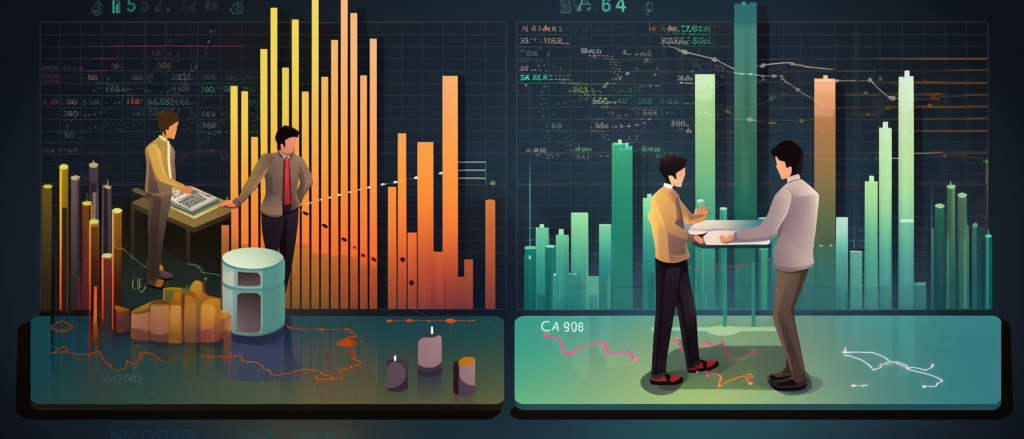Key Takeaways
✅ Focus and Scope: Marketing Analytics specifically concentrates on analyzing marketing-related data to understand consumer behavior, market trends, and campaign effectiveness. In contrast, Data Analytics encompasses a broader range of data analysis across various fields and functions within an organization.
✅ Tools and Techniques: Marketing Analytics often employs tools and techniques tailored for marketing purposes, such as customer segmentation, attribution modeling, and campaign performance analysis. Data Analytics, on the other hand, uses a wider array of tools and techniques, including machine learning and data mining, to extract insights from data.
✅ Outcome and Impact: Marketing Analytics is primarily concerned with optimizing marketing strategies to drive customer acquisition, retention, and revenue growth. In contrast, Data Analytics focuses on deriving insights to enhance overall operational efficiency and decision-making across various business functions.

Introduction
Ever stopped to wonder how a bunch of numbers and charts can transform your business? Well, it’s time to talk about two powerhouse players in the world of business intelligence: marketing analytics and data analytics. Why bother knowing the difference? Imagine having a map but reading it upside down. You could end up in the wild instead of at the treasure. That’s what mixing up these two could do to your decisions.
Marketing analytics is like using a zoom lens to get a clear shot of your marketing campaigns—every click, every call, every conversion. It’s all about making your marketing so effective; it’s like it’s got superpowers. On the flip side, data analytics is the eagle-eye view, soaring high, seeing far and wide across your whole company landscape, turning all that data into a blueprint for winning big.
You’ve got these high-tech tools and super-smart strategies, and every bit of them is designed to clue you into what’s working and what’s not. And it’s not just a numbers game—there’s real psychology in play, understanding why your customers tick the way they do.
So, are you ready to become a business wizard, harnessing the power of data? Let’s pull back the curtain and reveal how you can make those numbers sing and dance to the tune of your business growth. Trust me; by the end of this article, you’ll have a treasure trove of actionable insights and groundbreaking information that could very well redefine the way you look at your analytics. Stick around, and let’s decode this puzzle together.
Top Statistics
| Statistic | Why It Matters |
|---|---|
| Marketing Analytics Market Growth: Expected to reach $4.4 billion by 2025, growing at a CAGR of 14.3%. (Source: MarketsandMarkets) | This surge signifies how essential marketing strategies are in today’s landscape—companies are keen on investing more to figure out what really makes their customers tick. |
| Data Analytics Market Projection: Estimated to soar to $684.12 billion by 2030, with a CAGR of 13.5%. (Source: Allied Market Research) | This projection showcases the explosive importance of data across all industries, not just marketing, signaling that data’s role in decision-making is becoming more dominant than ever before. |
| Data-Driven Decision Making: 91% of marketers affirm data analytics is crucial for success. (Source: Forbes) | Almost all marketers agree that data isn’t just helpful; it’s a must-have. The ones who utilize data well are likely the ones who’ll lead the pack. |
| Informed Customer Experiences: 59% of marketers use data analytics to elevate the customer experience. (Source: Forbes) | Understanding customer behavior through analytics is growing because at the end of the day, if you’re making your customers happy, you’re likely doing something right. |
| Educational Background in Data Analytics: 57% of professionals have a bachelor’s degree, while 35% hold a master’s degree. (Source: Data Science Central) | This split tells us that higher education plays a significant role in the field of data analytics, indicating a highly skilled workforce driving the industry forward. |
Understanding Marketing Analytics
When we talk about marketing analytics, we’re getting into the nitty-gritty of how well a brand’s marketing campaigns are performing. It’s kind of like being a detective, but instead of solving crimes, you’re figuring out which ads make people click, buy, or even just smile at their screens. Imagine you’re running a bunch of ads online: marketing analytics helps you answer questions like “Which ad made the most dough?” and “Did that funny tweet actually sell any sneakers?”
Marketing analytics taps into data from your typical haunts like Facebook, your email newsletters, and your website. It uses this info to tell you things like how many people checked out your site after a campaign, which emails got people shopping, and which social media posts got folks talking.
Deciphering Data Analytics
Data analytics, on the other hand, is like the Swiss Army knife of number-crunching. It’s not just for marketing – it can tackle almost any kind of data you throw at it. So, this is less about ads and more about big-picture stuff. It could be about finding cheeky ways to save cash in your production line, spotting if someone’s trying to scam your business, or predicting what’s going to be the next big hit before it’s even a twinkle in a designer’s eye.
Imagine you own a bunch of coffee shops. Data analytics might tell you that people buy more muffins on Monday mornings or that a new rival café down the street is making your sales dip on Wednesdays. It’s the broader brush that paints over the whole canvas of your business, with data coming from absolutely everywhere – sales records, customer feedback, you name it.
Focus and Goals: Why they’re not the same
Here’s where the magnifying glass zooms in on specific goals. The whole idea of marketing analytics is to boost your ad game. It’s like a coach for your marketing team, telling them what plays work best to get more customers cheering. But data analytics doesn’t stop at marketing – it’s curious about everything. It could help plan your budget, make your stuff faster, or even figure out when to launch new products.
Tool Time: The Gizmos at Your Disposal
Sure, some of the tools and techniques cross paths. Marketing folks love playing around with Google Analytics, rummaging through click-rates on HubSpot, or measuring the mood on Marketo. They’ve got A/B testing down to an art, and they’re all about finding the value of a customer over their lifetime. Data analysts have a more powerhouse toolbox. They might code in R or Python to build mind-boggling models or use Tableau to make data look pretty enough to hang on the wall. Their world is full of algorithms, machine learning, and predicting the future like some sort of business fortune teller.
When Worlds Collide: Integrating for Impact
Even though marketing analytics and data analytics play in different sandboxes, when they team up, it’s a win-win. Imagine marketing analytics is telling you that customers love your snazzy new ad, but data analytics points out that it’s not actually making you any extra cash. That’s when you need to huddle up, get both teams talking, and make decisions that’ll really hit the mark.
Let’s Wrap Up with Insight
All in all, understanding the clear-cut differences between marketing analytics and data analytics can mean the world when it comes to making smart decisions. Whether it’s about grabbing more likes, cutting costs, or getting ahead of trends, both play crucial parts in a thriving business puzzle. It’s not about which one is better; it’s about how you can make both work for you in boosting your business to new heights.
AI Marketing Engineers Recommendation
Recommendation 1:Integrate marketing analytics and data analytics for a well-rounded strategy: While marketing analytics zeroes in on campaign performance and consumer behavior, data analytics can uncover broader business insights. For instance, use marketing analytics to track the success of your email campaigns, and data analytics to understand overall sales patterns and operational efficiencies. A tool like Google Analytics offers robust features for marketing insights, while platforms such as Tableau can cater to wider data visualization needs.
Recommendation 2: Focus on predictive analytics for proactive marketing decisions: Marketing analytics is adept at offering insights into what has worked well in your past campaigns, but by using predictive models from data analytics, you can anticipate customer behaviors and market trends. This foresight allows for crafting strategies that are not just reactive but also proactive. Keep an eye on AI predictive tools—they’re becoming more accessible and can provide predictions based on huge data sets that no human could analyze.
Recommendation 3: Implement data governance in your analytics to ensure data quality and compliance: This is critical as you dive deeper into both marketing analytics and data analytics, especially with the increase in data privacy regulations and consumer awareness. One can easily get lost in the quantities of data being analyzed without governance. Consider using a Customer Data Platform (CDP) to help manage your data and maintain high-quality, actionable datasets that comply with privacy standards.
Relevant Links
Boost Your Business with Advanced Marketing Guidance
– Skyrocket Your Affiliate Profits: Master the Art of Passive Income in 2024!
– Harness AI for Unstoppable Marketing: Transform Your Strategy Today!
– Cutting-Edge AI Tools for Your Business: Boost Efficiency & Innovation!
– The Future of Digital Marketing: Trends You Can’t Afford to Ignore
– From Analytics to Action: Elevate Your Marketing Game with Data Insights
SEO and Content Creation Mastery
– ChatGPT Unleashed: Revolutionize Your Content Game & Drive Sales!
– SEO Goldmine: Unlock Secrets to Soaring Search Rankings & Traffic!
– Tap into SEO Power: Craft an Ironclad Strategy for Dominating 2024
Leveraging AI for Business Advancement
– Supercharge Your Growth: Unleash the Power of ChatGPT for Your Business!
– AI’s Role in Refining SEO and PPC: Revolutionize Your Online Marketing!
– AI Ethical Use: Navigate the Challenges & Secure Your Brand’s Future
Conversion and Strategy Optimization Insights
– Maximize Conversion Rates: Learn the Art & Science of CRO
– Strategic Mastery: A Comprehensive Guide to Marketing Strategy Development
– Conquer Google Shopping: Strategies for Success & Visibility
Conclusion
Marketing analytics is like the trusty compass guiding a ship called ‘Marketing Campaign.’ It’s all about figuring out the ‘whys’ and ‘hows’ of a customer’s journey and ensuring your marketing efforts are nothing short of brilliant. We’re talking fine-tuning ads, making the most out of every dollar spent, and really getting what makes your audience tick.
Now, on the flip side, data analytics is the big picture – the satellite view. It steps back and takes in all sorts of information, from the number-crunching in your finances to predicting if that next big thing will wow your customers or not. It’s not just about marketing; it’s about the whole shebang of how your business breathes, moves, and evolves. Have you ever wondered how you could mish-mash these two worlds to really make some magic happen? It’s essential for marketing strategies to shake hands with the broader datasets. It’s for the savvy business that knows getting ahead means looking at the story from both angles. Integrating insights from both marketing analytics and data analytics can lead to those ‘aha’ moments, saving you time and upping your game.
Think about it. Are you really using all the knowledge you’ve got at your fingertips to drive your business forward? Are you using the right map and viewing the whole landscape? Learning to navigate the differences between these two analytical powerhouses can launch your strategies into new orbits, and hey, who doesn’t want that?
As we part ways, remember this: marketing analytics and data analytics are two sides of the same coin, but each holds its own value. You need both to buy your ticket to success. So, what’s your next move? How will you use this newfound clarity to outshine the competition and win over your audience? The power is in the data – it’s time to harness it.
FAQs
Question 1: What is the main difference between marketing analytics and data analytics?
Answer: Marketing analytics zeroes in on understanding how your marketing efforts are doing. Think of it like keeping an eye on your garden – seeing what blooms and what withers. Data analytics is the bigger picture – it’s like meteorology for your entire business landscape, drawing from all sorts of data weather patterns.
Question 2: Can marketing analytics and data analytics be used together?
Answer: Absolutely, they’re like peas and carrots. Marketing analytics is sneaking a peek at data analytics’ homework to get sharper insights, and data analytics doesn’t mind because it helps the whole business grow.
Question 3: What are some common tools used in marketing analytics and data analytics?
Answer: For marketing analytics, you might hang out with Google Analytics, Adobe Analytics, HubSpot, or Salesforce. For data analytics, you’ll find buddies in Tableau, Power BI, and the coding languages Python and R, which are like Swiss Army knives for data crunching.
Question 4: How do marketing analytics and data analytics help businesses make better decisions?
Answer: Imagine having a crystal ball that helps you understand your customers and see which strategies hit the jackpot. That’s marketing analytics for you. Data analytics is your broader business oracle, showing you patterns and trends spread out across your whole operation.
Question 5: What is the role of data visualization in marketing analytics and data analytics?
Answer: Ever tried to read a story with no pictures? Data visualization puts the pictures in the book so you can actually see the story your data’s telling, which makes it way easier to understand and act on.
Question 6: How can marketing analytics and data analytics be used to improve customer experience?
Answer: Marketing analytics is like being a detective in a boutique, figuring out what your customers love and tweaking your shop to make them smile. Data analytics chips in by examining everything customers touch – not just in your shop but in the whole mall – to smooth out any bumps in their stroll.
Question 7: What are some advanced topics in marketing analytics and data analytics?
Answer: For those craving more, marketing analytics offers fortune-telling with predictive modeling and a peek into customer value. Data analytics has its own bag of magic tricks with machine learning and big data juggling acts.
Question 8: What skills are required to become a marketing analytics or data analytics professional?
Answer: Aspiring marketing analysts need to be marketing-savvy data ninjas who know their way around the tools of the trade. Data analysts aim to be data whisperers, with a knack for numbers and coding languages like Python or R that help them chat up the data.
Question 9: What are some best practices for marketing analytics and data analytics?
Answer: Good habits for marketing analytics pros include goal-setting, data-driven strategies, and endless campaign fine-tuning. Data analytics folks should swear by data cleanliness, rule with data governance, and let data lead the boardroom dance.
Question 10: What are some relevant hashtags for marketing analytics and data analytics?
Answer: For social media savvy folks, tagging your insights with #MarketingAnalytics or #DataDrivenMarketing can put you in the marketing analytics spotlight. For data analytics, go ahead and sprinkle your tweets with #DataAnalytics or #BigData to join the cyber conversation.
Academic References
- Kaushik, A. (2013). Marketing Analytics: A Practitioner’s Guide to Marketing Analytics and Research Methods. John Wiley & Sons. This book delves into the realm of marketing analytics and its critical role in digging deeper into customer behavior, boosting marketing efficacy, and sharpening marketing strategies. Kaushik underscores how different it is from the broader field of data analytics through the lens of data-driven decision-making in marketing.
- Sathi, A. (2014). Big Data Analytics: Disruptive Technologies for Changing the Game. John Wiley & Sons. Sathi’s work is a treasure trove on the distinction between marketing and data analytics, stressing that the former hones in on marketing-specific data. The book talks about the contributions of big data in both sectors and its potential to revolutionize decision-making processes.
- Winston, W. L. (2014). Marketing Analytics: Data-Driven Techniques with Microsoft Excel. Pearson Education. Winston offers an insightful examination of marketing analytics in contrast to data analytics. He shines a spotlight on how marketing analytics zeroes in on predicting market movements, deciphering customer desires, and fine-tuning marketing maneuvers, while data analytics might branch into other business terrains such as finance and operations.
- Farris, P., Bendle, N., Pfeifer, P., & Reibstein, D. (2015). Marketing Analytics: A Primer. Pearson Education. In this comprehensive dive, the authors break down the nuances between marketing analytics and data analytics. They present the former as a specialized arm of data analytics, dedicated to marketing-centric data and choices, and advocate for marrying marketing analytics with the broader data analytics for bolstering business performance.













